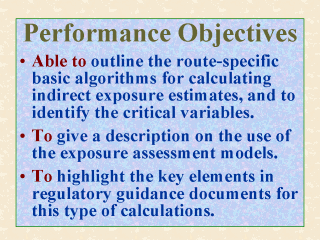| front |1 |2 |3 |4 |5 |6 |7 |8 |9 |10 |11 |12 |13 |14 |15 |16 |17 |18 |19 |20 |21 |22 |23 |24 |review |
 |
At the end of
this lecture, students are expected to be able to outline the various route- or
pathway-specific basic algorithms for calculating the indirect estimates of exposure to
environmental contaminants. They should also be able to identify and appreciate the
importance of some of the variables not explicitly included in these basic algorithms.
These other critical variables include, but are not limited to: absorption factor; exposure
duration; clothing penetration; inhalation rate; skin-soil loading;
Rault's law (e.g., for extrapolation of air level from water concentration); dermal
transfer rate; dislodgeable foliar residues; other surface residues,
etc. In addition, students are expected to be capable of giving a brief description on the applications and principles of the exposure assessment computer models discussed in this lecture. While they each represent years of efforts by the human exposure assessment (HEA) community, these computer models have been developed primarily to facilitate the numerous complex calculations involved. Students should be able to explain why the calculations in the indirect measurement methods (IMM) approach are numerous and complex, and why such calculations would give only indirect estimates of human exposures to environmental contaminants. Finally, students should be able to identify the key elements that regulatory agencies have specified in their guidance documents on IMM used in HEA. For lack of space, this lecture will only give a very brief discussion on these guidance documents. |